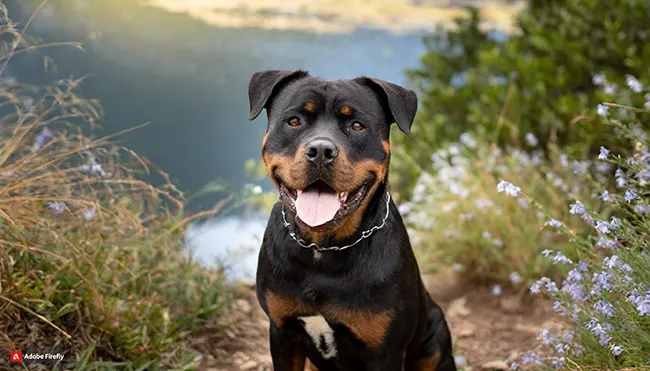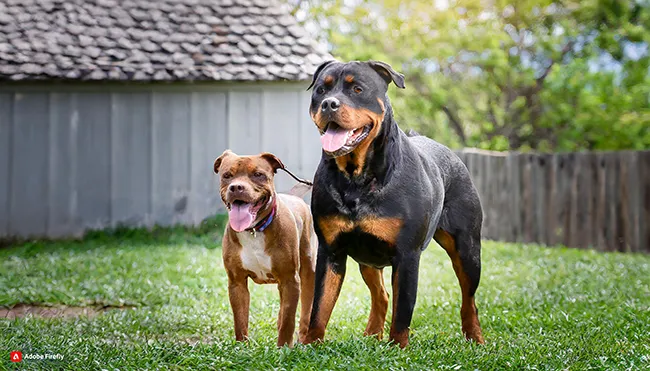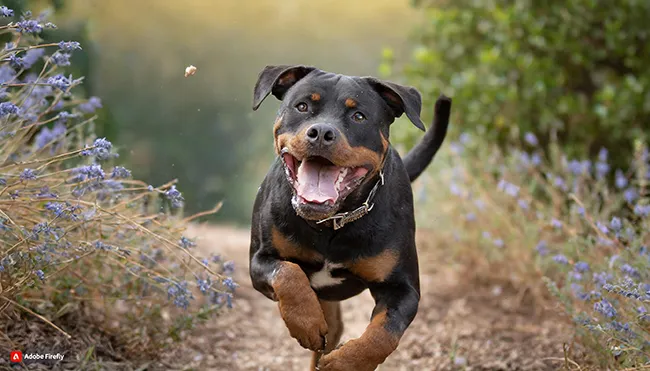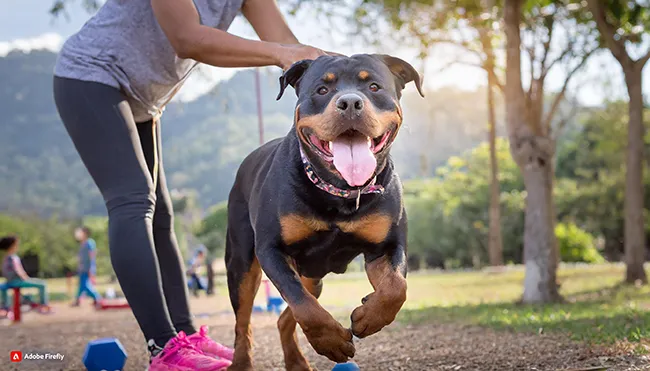The Rottweiler-Pitbull Mix: Understanding This Unique Crossbreed

MixbreedDogs.com is an Amazon Associate, and we earn from qualifying purchases.
The Pitbull Rottweiler Mix, often referred to as the Pitweiler, is a cross between two of the most formidable and misunderstood breeds: the Rottweiler and the American Pit Bull Terrier. This article delves into the characteristics, temperament, care needs, and common misconceptions surrounding this powerful hybrid, offering insights for potential owners and enthusiasts.
The Rottweiler-Pitbull mix combines the muscular build of a Rottweiler with the agility of a Pitbull, creating a robust and loyal companion. However, due to the reputations of both parent breeds, Pitweilers are often subject to controversy and misunderstanding. Understanding the true nature of this crossbreed is essential for appreciating its qualities and addressing the challenges of ownership.
Understanding the Pitweiler: Beyond the Myths
The Pitweiler inherits the muscular physique of a Rottweiler and the agility of a Pitbull, making for a robust and loyal companion. Unfortunately, due to widespread misconceptions surrounding both parent breeds, Pitweilers often face undue stigma. It’s essential to look beyond these stereotypes to appreciate the breed’s genuine qualities and understand the commitment involved in their care.
10 Facts About the Pitbull Rottweiler Mix

- Incredible Strength and Stamina: The Pitbull-Rottweiler mix inherits remarkable strength and stamina from both parent breeds, making it an energetic and resilient companion.
- Exceptional Loyalty: Known for their unwavering loyalty, these mixes form deep bonds with their families, showcasing dedication and protectiveness.
- Highly Trainable: With intelligence coming from both Rottweilers and Pitbulls, the Pitweiler is highly trainable, excelling in obedience, agility, and even service tasks.
- Versatile Working Dog: This mix has the versatility to perform various roles, from being a loyal family pet to engaging in work as a search and rescue dog, thanks to its adaptability and keen senses.
- Natural Protectors: Their protective instincts make them excellent watchdogs, always alert and ready to guard their loved ones against potential threats.
- Friendly with Proper Socialization: Despite their formidable appearance, with proper training and socialization from a young age, they can be incredibly friendly and gentle, even with children.
- Unique Appearance: Pitweilers have a distinctive look that combines the muscular build of a Pitbull with the robust frame of a Rottweiler, often accompanied by a variety of coat colors and patterns.
- Adaptable to Active Lifestyles: Ideal for active individuals or families, these dogs thrive in environments where they can expend their energy through play, walks, or training sessions.
- Long Lifespan for a Large Breed: With proper care, Pitbull-Rottweiler mixes can enjoy a lifespan that’s on the longer side for large breeds, offering years of companionship.
- Deep Emotional Sensitivity: They are known for their emotional sensitivity, often tuning into their owners’ feelings and offering comfort, making them not just pets but empathetic companions.
Origin and History
Rottweiler Background
The Rottweiler, originally bred in Germany for herding and as a guard dog, is known for its intelligence, strength, and loyalty. This breed was used to drive cattle and pull carts for butchers, a job that contributed to its strong build and protective instincts.
American Pit Bull Terrier Background
The American Pit Bull Terrier, with its origins in the British Isles, was initially bred for bull-baiting and later for farm work, hunting, and companionship. Despite its controversial reputation, the Pitbull is celebrated for its courage, tenacity, and affectionate nature towards its family.
The Rise of the Pitweiler
The Rottweiler-Pitbull mix likely originated in the late 20th century, with breeders aiming to combine the best traits of both parent breeds. While not recognized by major kennel clubs, the Pitweiler has gained popularity as a versatile and devoted companion.
Physical Characteristics of Pitbull Rottweiler Mix

The physical characteristics of the Rottweiler-Pitbull mix, or Pitweiler, reflect a fascinating blend of its parent breeds, showcasing a range of traits that make each individual dog unique. This section delves into the various aspects of the Pitweiler’s appearance, including size, build, coat, and color, offering a comprehensive overview of what potential owners might expect.
Size and Weight
Pitweilers are medium to large-sized dogs, with their weight typically ranging from 40 to 100 pounds. Their size largely depends on the dominant genes of the parent breeds and can even be influenced by the dog’s diet and exercise regimen. Males are often larger and more robust than females, though there can be significant variation within the breed.
Build and Musculature of Pitbull Rottweiler Mix
One of the most striking features of the Pitweiler is its sturdy, muscular frame. This dog inherits the best of both worlds: the solid, powerful build of the Rottweiler and the agility and athleticism of the American Pit Bull Terrier. This combination results in a dog that is both strong and nimble, capable of vigorous activity and requiring regular exercise to maintain its physical condition.
The Pitweiler’s body is usually compact and well-proportioned, with a broad chest, strong back, and well-muscled legs. The head can resemble either parent breed, displaying the blocky, wide head of the Pitbull or the more rounded, robust head of the Rottweiler. Ears may be medium in size, either drooping like a Rottweiler’s or semi-erect like a Pitbull’s, depending on genetics.
Read More: Muscular Pitbull
Coat Texture and Length
The coat of a Pitweiler can vary from short to medium in length, typically inheriting the dense, straight coat of the Rottweiler or the sleek, smooth coat of the Pitbull. The texture is generally firm and lies flat against the body, providing some insulation against weather conditions but not enough for extreme cold without additional protection.
Color and Markings
Pitweilers exhibit a wide range of colors and patterns, reflective of the diverse coloration of their parent breeds. Common colors include black, brown, tan, white, and brindle, with many dogs displaying a mix of these colors in their coats. The dark and tan markings characteristic of the Rottweiler are highly sought after, though not all Pitweilers will exhibit these. Similarly, the distinct patterns and hues of the Pitbull, such as solid colors, brindle, or patches, can also be present.
Tail and Other Features
The tail of a Pitweiler is another variable trait, with some inheriting the thicker, shorter tail of the Rottweiler and others the longer, whip-like tail of the Pitbull. Additionally, physical features such as the shape of the eyes, the configuration of the jaw, and the stance of the dog can vary, contributing to the unique appearance of each Pitweiler.
Genetic Diversity and Health Implications
The physical characteristics of the Pitweiler not only contribute to its aesthetic appeal but also have implications for its health. The genetic diversity resulting from the mix of two distinct breeds can lead to a robust constitution, but it also means potential owners should be aware of health issues common to both Rottweilers and Pitbulls, such as hip dysplasia and cardiac concerns. Regular veterinary check-ups and a healthy lifestyle are essential for mitigating these risks.
Temperament and Behavior of Pitweiler
The temperament and behavior of the Rottweiler-Pitbull mix, affectionately known as the Pitweiler, are key aspects that potential owners must understand to ensure a harmonious relationship with this breed. This comprehensive discussion will explore the complex nature of the Pitweiler, focusing on its intelligence, loyalty, protective instincts, and the importance of socialization and training.
Intelligence
Pitweilers inherit a high level of intelligence from both parent breeds. Rottweilers are renowned for their problem-solving abilities and willingness to work, while Pitbulls are celebrated for their eagerness to please and quick learning capabilities. This combination makes the Pitweiler an exceptionally trainable dog, capable of mastering a wide range of commands and tasks. Their intelligence, however, means they require mental stimulation to prevent boredom and destructive behavior. Puzzle toys, advanced training routines, and regular engagement are necessary to keep their minds active and content.
Loyalty and Affection
One of the most endearing qualities of the Pitweiler is its deep sense of loyalty and affection towards its family. They form strong bonds with their owners and are known to be particularly gentle and protective of children within their household, provided they have been raised together. This breed thrives on companionship and enjoys being involved in family activities. Despite their tough exterior, Pitweilers have a soft spot for their loved ones and often seek out cuddles and affection.
Protective Instincts
Both Rottweilers and Pitbulls have a natural inclination to protect their home and family, a trait that is strongly present in the Pitweiler. While this can be an admirable quality, it requires careful management to ensure that their protective instincts do not lead to aggressive behavior towards strangers or other animals. Understanding and respecting this aspect of their nature is crucial; with the right training and socialization, Pitweilers can learn to differentiate between normal interactions and genuine threats, reacting appropriately in various situations.
Socialization and Training
The key to nurturing a well-adjusted Pitweiler lies in early socialization and consistent, positive reinforcement training. Exposing them to a variety of people, animals, environments, and situations from a young age helps to build their confidence and reduce fear-based reactions. Socialization should be a positive experience, rewarding them for calm and friendly behavior.
Training should focus on obedience, manners, and impulse control, utilizing positive reinforcement techniques such as treats, praise, and play. Given their strong desire to please and impress their owners, Pitweilers respond well to this approach. It’s also important to establish clear leadership and boundaries, ensuring the dog understands its position within the family hierarchy.
Behavior with Other Animals
Given the right socialization, Pitweilers can coexist peacefully with other pets. However, their strong prey drive, inherited from the Pitbull side, may pose challenges with smaller animals. Careful introduction and supervised interactions are essential, especially in the early stages of bringing a Pitweiler into a home with existing pets.
Exercise and Activity Needs

The exercise and activity needs of the Rottweiler-Pitbull mix, or Pitweiler, are significant factors in their overall well-being. This energetic breed requires a well-rounded routine that not only maintains its physical health but also engages its sharp mind. Understanding and meeting these needs are essential for any Pitweiler owner who wishes to ensure their dog is happy, healthy, and well-adjusted.
Physical Exercise
Pitweilers possess a high energy level inherited from both parent breeds, necessitating regular, vigorous exercise to keep them physically fit and prevent obesity. The ideal exercise regimen for a Pitweiler includes:
- Daily Walks: At least one to two long walks per day are recommended. These walks not only provide physical exercise but also offer sensory stimulation as the dog explores new scents and sights.
- Playtime in a Secure Area: Given their strength and agility, Pitweilers benefit from playtime in a fenced yard or other secure areas where they can run freely and engage in games like fetch, tug-of-war, or agility training. This type of play not only exercises their body but also strengthens the bond between dog and owner.
- Structured Exercise: Activities such as hiking, jogging, or even participating in canine sports (e.g., agility, obedience trials) can provide structured outlets for their energy. These activities should be introduced gradually to ensure the dog’s physical safety.
Mental Stimulation
Pitweilers are intelligent and quickly become bored if not adequately stimulated, which can lead to destructive behaviors. Incorporating mental exercise into their daily routine is as important as physical activity. Effective methods include:
- Training Sessions: Regular, short training sessions that challenge them mentally, teaching new commands, or practicing existing ones, can be very stimulating.
- Puzzle Toys: Toys that require the dog to solve a problem to receive a treat are excellent for keeping their minds engaged. These toys can be particularly useful during times when physical exercise is not possible.
- Interactive Play: Games that require them to think and react, such as hide and seek or find the treat, can provide mental stimulation.
Socialization as Exercise
Social interaction with other dogs and people can also provide both mental and physical exercise. Playdates with other dogs, visits to the dog park, or participating in doggy daycare (for well-socialized dogs) can be beneficial. These interactions help to keep their social skills sharp and provide an outlet for pent-up energy.
The Importance of Routine
Establishing a routine that balances physical and mental exercise is crucial for a Pitweiler’s health. Consistency helps to manage their energy levels and prevent boredom, which can lead to undesirable behaviors. Owners should be prepared to commit to this routine daily, regardless of weather or personal schedule.
Adapting to Your Dog’s Needs
It’s important to note that every Pitweiler is an individual, and their exercise needs can vary based on age, health, and temperament. Puppies and young dogs typically have more energy and may require additional exercise and playtime. Older dogs, while less energetic, still benefit from regular, moderate exercise to maintain their health and mobility.
Health Considerations
The Rottweiler-Pitbull mix, or Pitweiler, is a robust and resilient crossbreed that benefits from the genetic diversity of its parentage. However, like all breeds, they are predisposed to certain health conditions that potential and current owners should be aware of. Understanding these health considerations is crucial for providing the best care and ensuring a long, healthy life for a Pitweiler.
Common Health Issues in Pitweilers
Hip Dysplasia
Hip dysplasia is a genetic condition often seen in larger breeds, where the hip joint does not fit together perfectly, leading to arthritis and pain. Both Rottweilers and Pitbulls are susceptible to this condition, making their offspring potentially at risk. Regular exercise to maintain a healthy weight and veterinary screenings can help manage this condition.
Heart Conditions
Heart conditions, including aortic stenosis and cardiomyopathy, have been observed in both Rottweilers and Pitbulls. These conditions can lead to heart failure if not diagnosed and managed early. Symptoms can include fatigue, difficulty breathing, and coughing. Regular veterinary check-ups are essential for early detection and treatment.
Allergies
Pitweilers can inherit a tendency towards allergies, which may manifest as skin irritations, dietary sensitivities, or reactions to environmental factors like pollen or chemicals. Allergies can cause discomfort and, in some cases, lead to more serious skin infections. Identifying and avoiding allergens, along with appropriate medical treatment, is key to managing this issue.
Preventative Measures and Care
Regular Veterinary Check-ups
Annual or bi-annual veterinary visits are crucial for early detection and management of potential health issues. Regular check-ups allow for timely vaccinations, parasite control, and health screenings that can prevent or mitigate serious conditions.
Healthy Diet
A balanced, nutritious diet tailored to their age, size, and activity level supports overall health and can prevent obesity, a risk factor for many health issues, including joint problems and diabetes. High-quality dog food that meets their nutritional needs, possibly supplemented with vitamins or minerals as recommended by a vet, can help maintain optimal health.
Exercise and Weight Management
Regular, appropriate exercise helps prevent obesity, keeping the Pitweiler’s joints healthy and mitigating the risk of hip dysplasia. It also supports cardiovascular health, reducing the likelihood of heart conditions. A balance of physical activity and a controlled diet is essential for weight management.
Monitoring and Early Intervention
Being vigilant about any changes in behavior, appetite, or activity level can lead to early detection of health issues. Prompt veterinary consultation in response to any concerns can make a significant difference in the outcome of various conditions.
Genetic Testing and Breeding Considerations
For breeders and owners interested in the genetic background of their Pitweilers, genetic testing can provide valuable insights into potential health risks. Responsible breeding practices, including health screening of breeding dogs for common conditions, can reduce the prevalence of inheritable diseases in offspring.
Ownership Challenges and Considerations
Owning a Rottweiler-Pitbull mix, or Pitweiler, can be a rewarding experience given their loyalty, intelligence, and protective nature. However, it also comes with specific challenges and considerations that potential owners must be prepared to address. Understanding these factors is crucial for ensuring the well-being of the dog, the safety of the community, and the peace of mind of the owner.
Breed-Specific Legislation (BSL) and Insurance Restrictions
One of the primary challenges faced by Pitweiler owners is navigating the complexities of Breed-Specific Legislation (BSL) and insurance restrictions. BSL refers to laws or regulations that restrict or prohibit the ownership of certain dog breeds, typically those perceived as “dangerous” or aggressive. Unfortunately, both Rottweilers and Pitbulls often fall under these categories, and by extension, their mixes may also be affected.
Owners may find that certain municipalities or housing complexes have restrictions or outright bans on owning these breeds or their mixes. This can limit housing options and necessitate thorough research before moving or traveling. Additionally, some insurance companies may refuse to provide homeowners’ or renters’ insurance to households that include breeds subject to BSL, or they may charge higher premiums.
To navigate these challenges, prospective Pitweiler owners should:
- Research Local Laws: Before acquiring a Pitweiler, investigate local BSL and housing policies to ensure compliance and avoid legal issues.
- Consult with Insurance Providers: Discuss with insurance agents to understand policy stipulations regarding dog breeds and consider shopping around for dog-friendly insurance options.
Commitment to Training and Socialization
Pitweilers, with their strong, protective instincts and high intelligence, require dedicated training and socialization from an early age. The commitment to properly train and socialize a Pitweiler cannot be understated; it is essential for preventing behavioral issues and ensuring the dog can interact safely with other animals and people.
Effective socialization exposes the dog to a variety of situations, people, and other animals in a controlled and positive manner, helping to build confidence and reduce fear or aggression. Training, on the other hand, establishes boundaries and commands, reinforcing desirable behaviors and discouraging unwanted ones.
Owners should be prepared to invest time and resources into:
- Professional Training Classes: Especially for novice dog owners, enrolling in puppy classes or working with a professional trainer can provide a solid foundation.
- Consistent Daily Training: Incorporate training into daily routines to reinforce commands and good behavior.
- Regular Socialization Opportunities: Arrange playdates, visit dog parks, and expose the dog to various environments and situations.
Exercise Needs
Pitweilers are energetic dogs that require regular exercise to maintain their physical and mental health. Potential owners must be prepared to provide daily walks, playtime, and mental stimulation to prevent boredom and destructive behaviors. The commitment to meet their exercise needs is crucial for a harmonious living situation.
Ethical Considerations and Public Perception
Owning a breed with a strong and sometimes intimidating appearance comes with the responsibility of managing public perception. Pitweiler owners may face prejudice or fear from others due to misconceptions about the breed. Educating the public, demonstrating responsible ownership, and ensuring the dog is a well-behaved ambassador for the breed are all part of the commitment.
Conclusion
The Rottweiler-Pitbull mix is a loyal, intelligent, and powerful companion that thrives under the care of experienced and dedicated owners. By understanding and respecting the needs of this unique crossbreed, owners can ensure a fulfilling and loving relationship with their Pitweiler.



